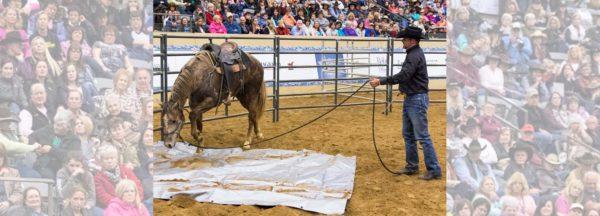Training Tip: Don’t Hang Out in a Shade of Gray With Your Horse

Be black or white with your horse. He’s either responding correctly or he’s not. Don’t be wishy-washy with him or inconsistent about what you consider acceptable and unacceptable. For example, let’s say you’re past the teaching stage of Backing Up: Tap the Air and are working on refining it. The first time you tap the air with your stick in front of the horse’s nose, he flicks a cigarette butt at you and halfheartedly shuffles backwards. You increase the pressure, looking for an energetic backup. As soon as he puts energy in his feet, you take the pressure away and reward him. The second and third times you ask him to back up, he immediately takes your cue seriously and hustles backwards.
The fourth time you tap the air with the stick, he puts in a lot less effort than the two previous times but you let it slide because, although he was lazy, his try was still better than the first time you asked him to back up.
The fifth time you ask him to back up, he gives you the same amount of effort. However, this time you hear my voice in your head and you decide that you’re not going to accept his sluggishness and correct him. Do you see how that’s confusing for your horse? Just a minute ago, you told him that being a little lazy was acceptable, but when he gave you that answer again, you changed your mind and made him feel uncomfortable for giving you that answer.
Put yourself in your horse’s place. When you were in school, I bet it’d be safe to say that you made the most progress with instructors who clearly laid out a lesson plan and made their expectations clear as opposed to instructors who were vague about what they expected and seemed to change their mind from one day to the next.
If your horse is not responding correctly, make your correction clear. Gordon McKinlay used to tell me all the time: One good whack is better than a thousand little taps. Nagging a horse only teaches him to be resentful and dull. When the horse gives you the correct response, immediately release the pressure. That’s his reward for doing the right thing. The faster you can reward him when he finds the right answer, the quicker he’ll catch on to the lesson.
The quicker you can jump from black to white and vice versa, the faster he will understand. You want him to realize that you’ll make him feel uncomfortable for the wrong behavior, but as soon as he tries to do the right thing, you’ll be quick to jump back to the other side and release the pressure.
The problem is that most people want to hang out in a shade of gray. They don’t really know for sure what their expectations are, which means the horse isn’t sure what’s expected of him, so he makes up his own rules. Let’s get that straight: If you’re not clear about what you want your horse to do, there is no hope in the world that he is going to know what to do either.
Have a horsemanship question or looking for more training tips? Check out the No Worries Club.
